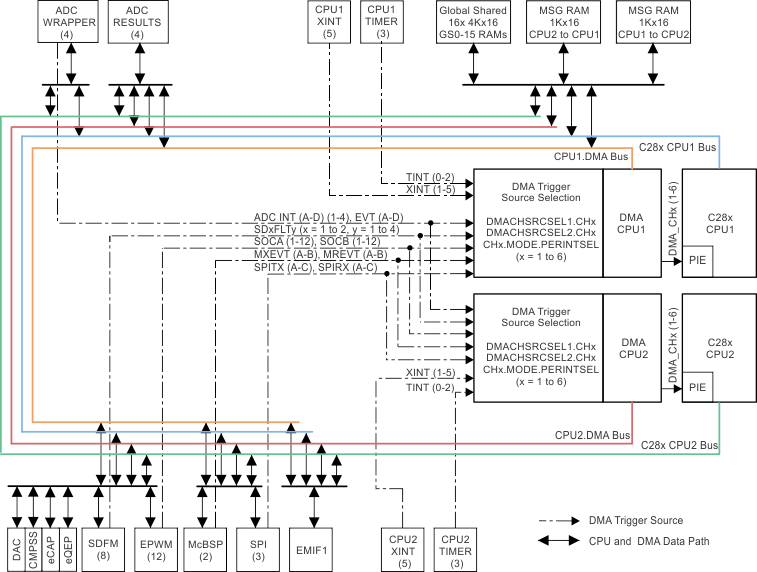SPRS880P December 2013 – February 2024 TMS320F28374D , TMS320F28375D , TMS320F28376D , TMS320F28377D , TMS320F28377D-Q1 , TMS320F28378D , TMS320F28379D , TMS320F28379D-Q1
PRODUCTION DATA
- 1
- 1 Features
- 2 Applications
- 3 Description
- 4 Device Comparison
- 5 Pin Configuration and Functions
-
6 Specifications
- 6.1 Absolute Maximum Ratings
- 6.2 ESD Ratings – Commercial
- 6.3 ESD Ratings – Automotive
- 6.4 Recommended Operating Conditions
- 6.5 Power Consumption Summary
- 6.6 Electrical Characteristics
- 6.7 Thermal Resistance Characteristics
- 6.8 Thermal Design Considerations
- 6.9
System
- 6.9.1 Power Sequencing
- 6.9.2 Reset Timing
- 6.9.3
Clock Specifications
- 6.9.3.1 Clock Sources
- 6.9.3.2 Clock Frequencies, Requirements, and Characteristics
- 6.9.3.3 Input Clocks and PLLs
- 6.9.3.4 XTAL Oscillator
- 6.9.3.5 Internal Oscillators
- 6.9.4 Flash Parameters
- 6.9.5 RAM Specifications
- 6.9.6 ROM Specifications
- 6.9.7 Emulation/JTAG
- 6.9.8 GPIO Electrical Data and Timing
- 6.9.9 Interrupts
- 6.9.10
Low-Power Modes
- 6.9.10.1 Clock-Gating Low-Power Modes
- 6.9.10.2 Power-Gating Low-Power Modes
- 6.9.10.3
Low-Power Mode Wakeup Timing
- 6.9.10.3.1 IDLE Mode Timing Requirements
- 6.9.10.3.2 IDLE Mode Switching Characteristics
- 6.9.10.3.3 STANDBY Mode Timing Requirements
- 6.9.10.3.4 STANDBY Mode Switching Characteristics
- 6.9.10.3.5 HALT Mode Timing Requirements
- 6.9.10.3.6 HALT Mode Switching Characteristics
- 6.9.10.3.7 HIBERNATE Mode Timing Requirements
- 6.9.10.3.8 HIBERNATE Mode Switching Characteristics
- 6.9.11 External Memory Interface (EMIF)
- 6.10
Analog Peripherals
- 6.10.1
Analog-to-Digital Converter (ADC)
- 6.10.1.1 ADC Configurability
- 6.10.1.2
ADC Electrical Data and Timing
- 6.10.1.2.1 ADC Operating Conditions (16-Bit Differential Mode)
- 6.10.1.2.2 ADC Characteristics (16-Bit Differential Mode)
- 6.10.1.2.3 ADC Operating Conditions (12-Bit Single-Ended Mode)
- 6.10.1.2.4 ADC Characteristics (12-Bit Single-Ended Mode)
- 6.10.1.2.5 ADCEXTSOC Timing Requirements
- 6.10.1.2.6 ADC Input Models
- 6.10.1.2.7 ADC Timing Diagrams
- 6.10.1.3 Temperature Sensor Electrical Data and Timing
- 6.10.2 Comparator Subsystem (CMPSS)
- 6.10.3 Buffered Digital-to-Analog Converter (DAC)
- 6.10.1
Analog-to-Digital Converter (ADC)
- 6.11
Control Peripherals
- 6.11.1 Enhanced Capture (eCAP)
- 6.11.2 Enhanced Pulse Width Modulator (ePWM)
- 6.11.3 Enhanced Quadrature Encoder Pulse (eQEP)
- 6.11.4 High-Resolution Pulse Width Modulator (HRPWM)
- 6.11.5 Sigma-Delta Filter Module (SDFM)
- 6.12
Communications Peripherals
- 6.12.1 Controller Area Network (CAN)
- 6.12.2 Inter-Integrated Circuit (I2C)
- 6.12.3 Multichannel Buffered Serial Port (McBSP)
- 6.12.4 Serial Communications Interface (SCI)
- 6.12.5 Serial Peripheral Interface (SPI)
- 6.12.6 Universal Serial Bus (USB) Controller
- 6.12.7 Universal Parallel Port (uPP) Interface
-
7 Detailed Description
- 7.1 Overview
- 7.2 Functional Block Diagram
- 7.3 Memory
- 7.4 Identification
- 7.5 Bus Architecture – Peripheral Connectivity
- 7.6 C28x Processor
- 7.7 Control Law Accelerator
- 7.8 Direct Memory Access
- 7.9 Interprocessor Communication Module
- 7.10 Boot ROM and Peripheral Booting
- 7.11 Dual Code Security Module
- 7.12 Timers
- 7.13 Nonmaskable Interrupt With Watchdog Timer (NMIWD)
- 7.14 Watchdog
- 7.15 Configurable Logic Block (CLB)
- 7.16 Functional Safety
- 8 Applications, Implementation, and Layout
- 9 Device and Documentation Support
- 10Revision History
- 11Mechanical, Packaging, and Orderable Information
Package Options
Refer to the PDF data sheet for device specific package drawings
Mechanical Data (Package|Pins)
- PTP|176
Thermal pad, mechanical data (Package|Pins)
Orderable Information
7.8 Direct Memory Access
Each CPU has its own 6-channel DMA module. The DMA module provides a hardware method of transferring data between peripherals and/or memory without intervention from the CPU, thereby freeing up bandwidth for other system functions. Additionally, the DMA has the capability to orthogonally rearrange the data as it is transferred as well as “ping-pong” data between buffers. These features are useful for structuring data into blocks for optimal CPU processing.
The DMA module is an event-based machine, meaning it requires a peripheral or software trigger to start a DMA transfer. Although it can be made into a periodic time-driven machine by configuring a timer as the interrupt trigger source, there is no mechanism within the module itself to start memory transfers periodically. The interrupt trigger source for each of the six DMA channels can be configured separately and each channel contains its own independent PIE interrupt to let the CPU know when a DMA transfer has either started or completed. Five of the six channels are exactly the same, while Channel 1 has the ability to be configured at a higher priority than the others.
DMA features include:
- Six channels with independent PIE interrupts
- Peripheral interrupt trigger sources
- ADC interrupts and EVT signals
- Multichannel buffered serial port transmit and receive
- External interrupts
- CPU timers
- EPWMxSOC signals
- SPIx transmit and receive
- SDFM
- Software trigger
- Data sources and destinations:
- GSx RAM
- CPU message RAM (IPC RAM)
- ADC result registers
- ePWMx
- SPI
- McBSP
- EMIF
- Word Size: 16-bit or 32-bit (SPI and McBSP limited to 16-bit)
- Throughput: four cycles/word (without arbitration)
Figure 7-3 shows a device-level block diagram of the DMA.
 Figure 7-3 DMA Block Diagram
Figure 7-3 DMA Block Diagram